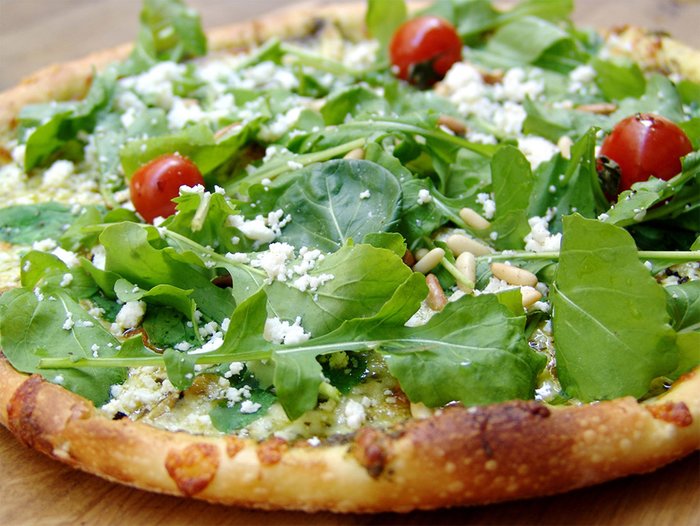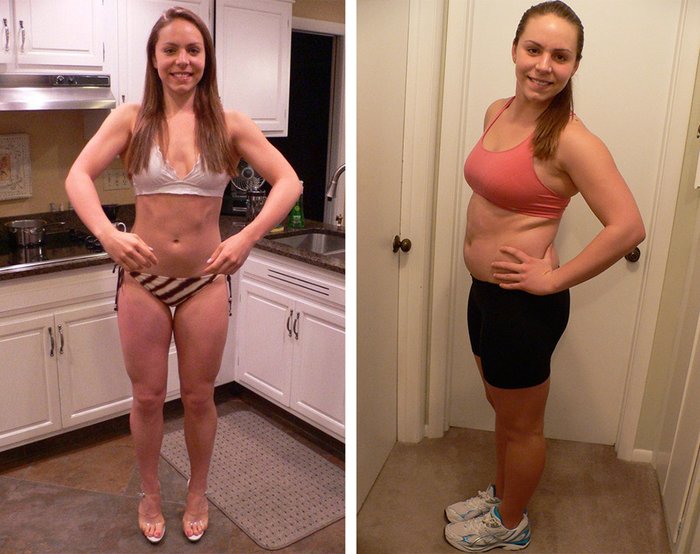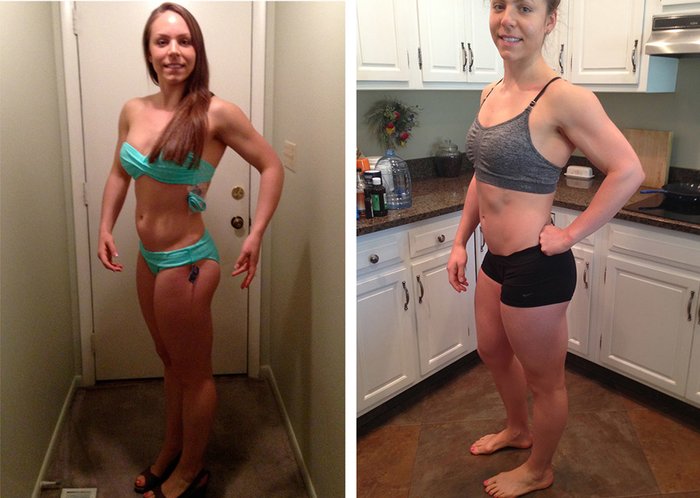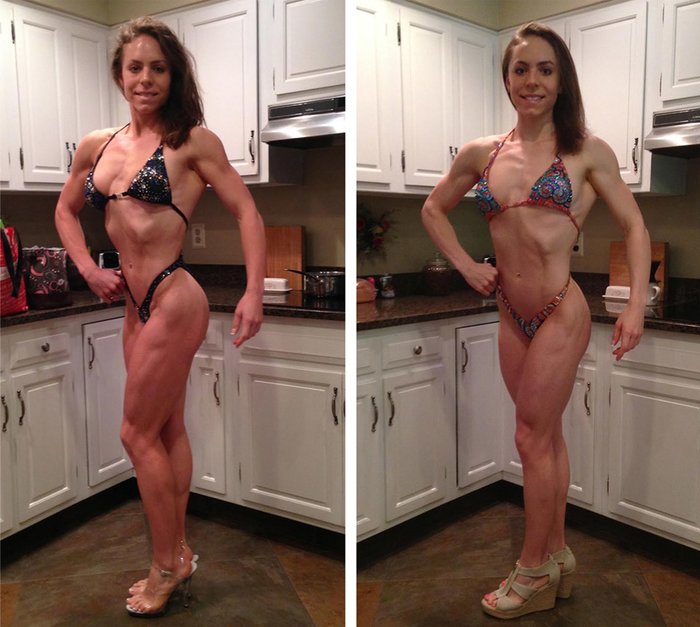When most people decide they want to take control of their physique and lose some fat, the next step seems clear: Go on a diet. But honestly, not everyone should take that step.
For those with a history of crash dieting, severe calorie restriction, or multiple failed diet attempts, jumping once more on the diet bandwagon is unlikely to yield results, and will probably do more harm than good.
Over repeated bouts of calorie restriction, your metabolism takes a beating. When you drop calories too low for too long, your body intervenes on several fronts. Most notably, it reduces the number of calories you burn throughout the day, often priming your body for surprisingly rapid weight gain.
This biological phenomenon, known as "metabolic adaptation," can really throw a wrench in your weight-loss goals. With your body continuously fighting to erase the calorie deficit necessary for fat loss, eating fewer calories than you burn can eventually become very tricky. You can only drop calories so far and increase exercise so much before that lifestyle becomes miserable, as well as impossible to maintain.
Fortunately, for anyone fighting an uphill battle against a slow metabolism, there may be a solution. It's possible to reboot metabolism and ultimately lower what's known as your "body-fat set point"—or the level of body fat your body finds easiest to maintain— through a process known as "reverse dieting."
Here's everything you need to know to get started with what may turn out to be the best diet of your life!
What Is Exactly Reverse Dieting?
Reverse dieting is pretty much what it sounds like: a diet turned upside-down. Instead of cutting calories and ramping up time spent on the treadmill, you increase metabolism by gradually adding calories back into your diet while reducing cardio.

Although it sounds very simple, there's more to reverse dieting than just "eat more, do less." If you want to maximize gains in metabolic rate without storing a ton of body fat, you must be strategic and patient. This means giving your metabolism time to adjust by making slow, deliberate changes, rather than hitting the buffet every day and cutting out cardio overnight.
To grasp the science behind the theory of reverse dieting, you need to understand what happens in your body during metabolic adaptation.
Metabolic Adaptations From Dieting
When you drastically restrict calories or lose weight, your body senses the energy gap and your departure from its body-fat set point. In a desperate attempt to erase the energy gap and put the brakes on fat loss, several body systems work together to orchestrate a reduction in metabolism[1,2]:
- Your organs consume less energy.
- Your heart beats slower as sympathetic nervous system activity declines.
- Hormones that influence metabolism and appetite, such as thyroid hormone, testosterone, leptin, and ghrelin, are adversely effected.
- You burn less energy during nonexercise activities, such as fidgeting, walking around the house, working, and doing chores.
- You use fewer calories to absorb and digest food because you're eating less.
- Your muscle becomes more efficient, requiring less fuel for a given amount of work.
These changes ultimately boil down to burning fewer calories, both at rest and while working out. This sounds bleak, but luckily, metabolic adaptation is not a one-way street.
You can slow down your metabolism, but you can also speed it up! This is what the concept of reverse dieting is built upon. Many of the physiological changes that work to slow metabolism during calorie restriction can occur in the opposite direction when overeating to make metabolism faster.[1]

You can't just go on a pizza binge and expect metabolism to increase overnight. It takes time!
But you can't just go on a pizza binge and expect metabolism to increase overnight. It takes time! This was demonstrated when researchers at Laval University in Quebec overfed 24 men by 1000 calories for 84 days.[3] At first, almost all of the extra calories turned into fat or contributed to lean mass. By the end of the study, however, as each subject's metabolism adapted, more and more calories were burned, rather than being used to create new tissue.
The moral of the story is that metabolism will speed up eventually to dispose of some of the extra calories you eat. But if you drastically increase calories before your metabolism has time to catch up, you'll pile on the pounds.
A Reverse-Dieting Success Story
While the science supporting metabolic adaptation is sound, there is currently no definitive research on the actual process of reverse dieting. But this doesn't mean that there aren't plenty of people out there experiencing real-life success stories with reverse dieting. To help show you what this approach looks like in action—down to the macros—let's meet one of those success stories. Her name is Katie Anne Rutherford.
As a high school track athlete, Katie Anne wanted to become as fast as possible. In her mind, this meant getting rid of any extra weight that might slow her down. Being thin was the name of the game. This mentality sparked an unhealthy relationship with food that would plague her for years.
To lose weight, Katie Anne began eliminating food groups and cutting calories. At her lowest, she was eating about 1,300 calories and running over 7 miles per day. Fruit, vegetables, and lean protein made up the bulk of her diet, while bread, sugar, and dessert were forbidden.
Feeling deprived, Katie Anne had a history of binge eating. Food became a source of comfort during times of stress, and she couldn't seem to find balance. Alternating between eating hardly anything and eating everything, she was miserable.
Katie Anne's diet struggles continued into college, where she started on a 1,500-calorie "standard" bodybuilding diet of lean protein and veggies. Paired with 90 minutes of cardio each day, she successfully lost 20-25 pounds a few different times.
Unfortunately, this success was never long-lived. Unable to stick to the diet, she gained the weight back each time. Living a life preoccupied by food, she had become a slave to her diet and the scale.

Unable to stick to the diet, Katie Anne gained the weight back each time. Living a life preoccupied by food, she had become a slave to her diet and the scale.
In 2013, Katie Anne came across two of Layne Norton's YouTube videos: "IIFYM vs. Clean Eating" and "Metabolic Damage." She realized that her metabolism had adapted to her restrictive eating regimen and excessive cardio routine. This motivated her to start "flexible dieting"; rather than restricting certain foods, she began engineering her diet around carbs, protein, and fat.
Although it was liberating to eat more than just lean protein and veggies, Katie Anne was still subsisting on low calories—a restriction that led to continued binging episodes. She was sick of the ups and downs and frequent urges to binge, and she felt as if she was being held hostage by a low-calorie diet that was difficult to maintain. At this point, she realized that a reverse diet with higher calories might help add some stability to her nutritional life.
In April 2013, Katie Anne officially began her first reverse diet. She started out eating 190 grams of protein, 200 grams of carbs, and 50 grams of fat (2010 calories) while lifting weights and doing four sessions of cardio per week. From there, she increased her calories quickly, adding 15 grams of extra carbs and 2 grams of extra fat each week, and reduced her cardio by half a session each week.
Choosing such an aggressive reverse diet quickly gave her more calories to work with, helping to reduce cravings and the urge to binge by allowing her to fit more food into her diet. She also felt better. Katie Anne focused more on becoming strong and healthy, and defeating her binge-eating habits. She never weighed herself during the reverse-dieting process.
In April 2014, at the end of her reverse diet, Katie Anne had gained 10 pounds and was maintaining this weight on 200 grams of protein, 375 grams of carbs (+175), 65 grams of fat (+15) (2885 calories, +875), and no cardio. She was able to gain strength and put on a substantial amount of muscle through heavy lifting, and had improved her relationship with food.

Katie Anne was able to gain strength and put on a substantial amount of muscle through heavy lifting, and had improved her relationship with food.
After training for a figure competition in November 2014, Katie Anne decided to reverse diet again. This time, she opted for a slower, more conservative reverse to minimize fat gain, starting at 180 grams of protein, 200 grams of carbs, and 52 grams of fat (1988 calories) while lifting weights and doing no cardio.
She increased carbs and fat by just 5 grams and 1 gram each week. By the end of the reverse, she hadn't gained any weight and was eating 170 grams of protein, 320 grams of carbs (+120), and 80 grams of fat (+28) for a total of 2680 calories (+692) per day, and still not doing any cardio.

By the end of the reverse, katie anne hadn't gained any weight and was eating 170 grams of protein, 320 grams of carbs (+120), and 80 grams of fat (+28) for a total of 2680 calories (+692) per day, and still not doing any cardio.
Today, Katie Anne has been binge-free for two years. She's stronger and healthier than ever, and is maintaining a lean physique at 2400 calories per day—a figure that is 900 calories higher than when she was at her lowest body fat three years ago.

When done correctly, reverse dieting may reset your body-fat set point and allow you to eat normally and live again.
The moral of the story: When done correctly, reverse dieting may reset your body-fat set point and allow you to eat normally and live again. Here's how to do it correctly.
How To Reverse Diet
Through reverse dieting and heavy lifting, Katie Anne harnessed the power of metabolic adaption to turn her body into a calorie-burning machine. You may be able to do this too by following these six steps:
1. Calculate Your Current Calories And Establish Starting Macro Targets
To avoid jumping up in calories too quickly, you need to know how many calories you're currently eating to maintain your body weight. From there, you'll use this to establish baseline macros.
First, track everything you eat for a few days to determine your average caloric intake. Let's say it's 1,800 calories.
Second, set your protein target at 1 gram per pound of body weight. If you weigh, say, 150 pounds, your protein intake will be 150 grams of protein.
Third, subtract your protein calories from your current total-calorie goal to determine the remaining calories:
- 150 grams of protein x 4 calories per gram = 600 calories of protein.
- 1800 total calories - 600 calories from protein = 1200 remaining calories.
Take your remaining calories, and split them 40/60 or 60/40 between carbs and fat. These numbers can be manipulated, but either one of the above is a good starting place.

Let's say in this example that you love carbs, so you decide to set carbs at 60 percent and fat at 40 percent of the remaining calories.
- 1200 x 0.6 = 720 calories from carbs
- 1200 x 0.4 = 480 calories from fat
To determine your macros, divide the carb calories by 4 and fat calories by 9.
- 720 calories of carbs / 4 calories per gram = 180 grams of carbs
- 480 calories of fat / 9 calories per gram = 53 grams of fat
You now have your baseline macros. In this example, they are 150 grams of protein, 180 grams of carbs, and 53 grams of fat.
2. Decide How Quickly You Want To Increase Carbs And Fat
To figure this out, you need to ask yourself a few questions:
- Do I care more about reaching a higher caloric intake than I do about gaining excess fat?
- Am I trying to overcome a history of binge-eating behavior?
- Am I planning to hit the weight room hard and add muscle while I reverse?
If the answer to any of these questions is "yes," you may benefit from a more aggressive reverse. Although you'll likely gain more body fat by increasing carbs and fat quickly, you'll feel better and less deprived, you'll have more flexibility to fit in the foods you crave, and you'll be less inclined to binge. The extra calories that accompany an aggressive reverse may also give you more energy to train, allowing you to build muscle.
If you're concerned about gaining body fat, you may benefit from a more conservative reverse. For example, if you're coming off a reasonable diet where you reached your goal body weight, you may want to increase fat and carbs more slowly to better maintain your results.
3. Raise Carbs And Fat At A Rate Compatible With Your Goals
If you've decided that a slow reverse is more in line with your goals, start by increasing your carb and fat intake by just 2-5 percent per week, depending on how concerned you are with gaining weight.
If you've decided that a fast reverse is for you, you should start by increasing your carb and fat intake by 6-10 percent per week. You may even want to increase fat and carbs by 15-25 percent the first week to give yourself a jump-start.

4. Weigh Yourself Multiple Times Per Week To Control Weight Gain
Choose 2-3 days per week, and weigh yourself first thing in the morning. Assessing your average weight change over the course of the week will help you evaluate your macro manipulations and decide on your next increase (if necessary).
If you see a large jump in weight gain over a one-week period, you may want to scale back the rate at which you're increasing your intake. On the other hand, if you maintain your current weight, or even lose slightly, bump up both carbohydrates and fat.
5. Slowly Reduce The Time You Spend Doing Cardio, And Add Heavy Lifting To Your Workout Routine
Lifting heavy 3-6 days a week is a great way to build muscle, which increases metabolism not only in the short term, but also over the long run. Long sessions of steady-state cardio do little to build muscle, and they may even interfere with muscle-building pathways.[4]
6. When You Reach Your Desired Caloric Intake, Stop And Choose Your Next Action
Once you're satisfied with the amount of food you're eating, stop adding calories and go from there. If you feel good, you may want to stay at this level. If you'd like to lose weight now that your metabolism is at a better starting point, go right ahead!
But be smart about how you go about it; don't recklessly slash calories. You'll want to diet on as many calories as possible while still losing weight. Your metabolism depends upon it.
If you need more guidance on reverse dieting, check out Layne Norton’s Avatar Nutrition for a customized coaching experience that adapts to your ever-changing metabolic demands.
References
- Rosenbaum, M., & Leibel, R. L. (2010). Adaptive thermogenesis in humans. International Journal of Obesity, 34, S47-S55.
- Levine, J. A. (2002). Non-exercise activity thermogenesis (NEAT). Best Practice & Research Clinical Endocrinology & Metabolism, 16(4), 679-702.
- Deriaz, O., Tremblay, A., & Bouchard, C. (1993). Non linear weight gain with long term overfeeding in man.Obesity Research, 1(3), 179-185.
- Fyfe, J. J., Bishop, D. J., & Stepto, N. K. (2014). Interference between concurrent resistance and endurance exercise: Molecular bases and the role of individual training variables. Sports Medicine, 44(6), 743-762.

